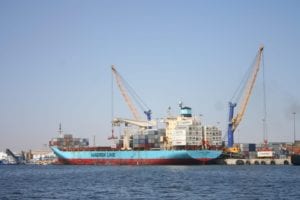Construction of the N$3 billion container terminal at Walvis Bay is taking shape with over 1.5 million cubic metres of land reclaimed from the Atlantic Ocean.
China Harbour Engineering Company (CHEC), which is constructing the terminal, says the work is on schedule for completion in 2017. “We understand the importance of the project not only for Namibia but for Africa as a continent and therefore we are fully committed to deliver a state-of-the-art project at the end,” said CHEC’s acting project manager, Feng Yuan Fei. The expansion includes the construction of a modern container terminal, adding 600m of quay length to the existing 1500m and 650 000 TEU (twenty-foot equivalent unit) per annum capacity to the existing 350 000 TEU. The Namibia Port Authority (Namport) port engineer, Elzevir Gelderbloem, said Namport is happy with the progress made so far. “It took us nine years to get to the construction phase of the project. Such projects take time to implement and we hope our next projects will be much quicker. However, we have no dry land to expand as the harbour is completely boxed in by the town, but with the current project we are creating more land in water. This type of expansion is unique and feasible for a container terminal.“It’s the kind of construction that has never been used in the country but will improve our port services at least until 2020 when we will have to undergo the same process again,” he said.
The Governor of Erongo Region, Cleophas Mutjavikua, recently received a briefing on the progress on construction. CHEC said it remains fully committed to adhere to health and safety regulations and has applied various control measures to mitigate issues such as dust and noise pollution. Reclamation of the land is scheduled for completion in February next year, after which the next phase is to complete the quay walls by April and then the construction of revetment by August in the same year. Erection of revetment involves the layering of different rock such as armour core rock, mixed filter layer, geotextile, and crushed stone layers to create a wall around the reclaimed land. More than 400 000 cubic metres of rock will be needed for revetment. Feng said he was confident they would comfortably meet the deadline to complete the revetment in August next year. “We also created a sandbag cofferdam, which prevents the dredged material and muddy water from overflowing during the process of reclamation,” he said. Source: New Era newspaper







